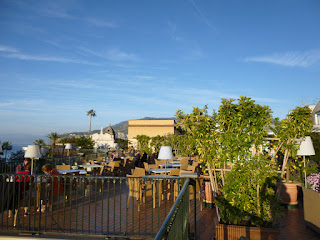Getting off the beaten track can be overrated, but in Venice there really is another world to discover. pic.twitter.com/eApFuQMrhX— Emily@italyheaven (@italyheaven) 15 January 2016
There was ice between the paving stones elsewhere in Venice but on the Zattere they were lunching outdoors. pic.twitter.com/QZJ6EPXja1— Emily@italyheaven (@italyheaven) 17 January 2016
In March I climbed up Venice's famous spiral staircase, Scala Contarini del Bovolo, for the first time.
Finally reopened, Venice's most amazing staircase. Here is the view from the top. I've waited years for this. pic.twitter.com/nr1lEI8mgv— Emily@italyheaven (@italyheaven) 10 March 2016
At Easter I spent a week in Sorrento, with misgivings. It turned out well and I found some lovely spots on the peninsula including hilltop villages, the beach at Marina del Cantone and a weird, haunted summer holiday 'village'.
Sorrento yellow pic.twitter.com/WEhIcUxxMW— Emily@italyheaven (@italyheaven) 29 March 2016
Yesterday I followed a path along the seashore & came to this strange and eerie bay of shuttered beach houses. pic.twitter.com/ecxIeEf1md— Emily@italyheaven (@italyheaven) 4 April 2016
I visited Herculaneum for the first time, and enjoyed a peaceful tour of the Villa Oplontis for a view of how the wealthy Roman elite lived.
Herculaneum, modern Ercolano and Vesuvius (which did for the first town and will probably do for the second). pic.twitter.com/IDlYvtseIe— Emily@italyheaven (@italyheaven) 4 April 2016
Frescoes & colonnades at Villa Oplontis, nr Pompeii, possibly an empress's seaside palace https://t.co/WRonMtxtEP pic.twitter.com/JHVLKSJJwn— Emily@italyheaven (@italyheaven) 14 April 2016
Venice in spring is busier than in winter, but you do get to enjoy the bright colours and wisteria of the springtime city.
Front seat of the bus, Venice. pic.twitter.com/F4l5I52rYD— Emily@italyheaven (@italyheaven) 11 April 2016
The island of Capri is usually my answer to the question "Where's your favourite place in Italy?" After a few years away I had forgotten just how glorious the scenery and history really are.
Lunch, Da Gelsomino alla Migliera. Ravioli alla caprese & wine from the restaurant's vineyard. pic.twitter.com/KPljKVpVYA— Emily@italyheaven (@italyheaven) 13 May 2016
The weather was unseasonably cold for May, but I managed some walks, meals in scenic spots, a trip to watch bird conservationists at work, and an entirely unnecessary extra climb up the hill when I dropped my new swanky sunglasses on my final morning. I was also lucky enough to see the annual procession and celebrations of Capri's saint, San Costanzo.
Dropped my new & expensive sunglasses in this scenic spot; had to climb back up the mountain to retrieve them. pic.twitter.com/hwMgi4MdSK— Emily@italyheaven (@italyheaven) 18 May 2016
Festa di San Costanzo, Capri. The saint's silver effigy, studded with Roman gems, is paraded & showered with petals. pic.twitter.com/EXcWfOCWhL— Emily@italyheaven (@italyheaven) 16 May 2016
After Capri I think I spent only one or two days in London before taking another flight, to Sicily this time. I had fancied a week getting away from it all on the Aeolian islands. Tiny, chic Panarea is the perfect place to relax ... or work. The staff of the Hotel Cincotta used ropes to haul a table onto my seafront terrace so I could work in comfort.
Brought a book to breakfast, but I think I'll just enjoy the view. pic.twitter.com/0BPwPptYE0— Emily@italyheaven (@italyheaven) 23 May 2016
The kind hotel staff used ropes to haul a table onto my terrace so I could work comfortably. Best workplace ever. pic.twitter.com/1bjpFD80zL— Emily@italyheaven (@italyheaven) 22 May 2016
After a few nights on Panarea I travelled to the livelier Lipari where I was gratified to be remembered by a few locals, took a panoramic walk and worked on a rooftop
.
Today's walk was from the @ciceronepress Sicily book. Alarming ending in a storm drain, but fabulous views en route. pic.twitter.com/K0ssYP1QWu— Emily@italyheaven (@italyheaven) 25 May 2016
I made a summer trip to Venice where greenery peeps out from the buildings in unexpected places, and where I found surprising pleasure in pottering about in sunshine, sitting on ferries and doing nothing on the beach.
Summer greenery among the buildings of Dorsoduro, Venice. pic.twitter.com/uHvVdtCPlz— Emily@italyheaven (@italyheaven) 6 July 2016
The Lido is at its best today. pic.twitter.com/8D2MTVUfI8— Emily@italyheaven (@italyheaven) 30 June 2016
In early September I headed back to Campania for some late summer sun, this time returning to the islands of Ischia and Procida. I arrived on Ischia in time to see a re-enactment - with fireworks - of Saracen invasions and spent a few days getting to know the island. My favourite and most surprising excursion was to the island's highest point, Monte Epomeo which offers both attractive scenery for walking and an open-air restaurant.
I fancy exploring this path next. pic.twitter.com/A3057zwVhc— Emily@italyheaven (@italyheaven) 11 September 2016
I also tracked down a couple of the filming locations for the 1960 film Plein Soleil, starring Alain Delon.
I was pleased to find that little Procida still has the 1950s charm I was so impressed by when I first visited.
Procida, looking picturesque. pic.twitter.com/eLK8DNt2eg— Emily@italyheaven (@italyheaven) 13 September 2016
By December I was back in wintry Venice for my last trip of the year, in a rented flat with a glorious view over a campo, and enjoying a mixture of sunshine and fog.
Tonight pic.twitter.com/zF5rwWW52g— Emily@italyheaven (@italyheaven) 13 December 2016
To follow 2017's Italy travels and website updates you can follow my Twitter account here:
https://twitter.com/italyheaven
Read more about:
Venice
Sorrento
Herculaneum
Capri
Panarea
Lipari
Ischia
Procida



















































